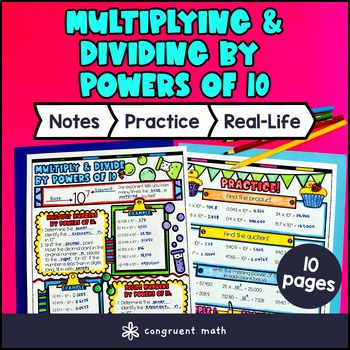Want more ideas and freebies?
Get my free resource library with digital & print activities—plus tips over email.
Join for Free Resources →
$4.25
Ever wondered how to teach multiplying and dividing decimals by powers of 10 in an engaging way to your 5th-grade students?
In this lesson plan, students will learn about multiplying and dividing by powers of 10 and their real-life applications. Through artistic, interactive guided notes, check for understanding, practice with a doodle coloring activity, and a maze worksheet, students will gain a comprehensive understanding of this topic.
The lesson ends with a real-life example that explores how multiplying and dividing by powers of 10 are used in everyday situations. Students will read and write about these applications to deepen their understanding further.

$4.25
After this lesson, students will be able to:
Before this lesson, students should be familiar with:
As a hook, ask students why understanding how to multiply and divide decimals by powers of 10 is important in real-life situations. Refer to the last page of the guided notes as well as the FAQs below for ideas.
Use the first page of the guided notes to introduce the concept of multiplying decimals by powers of 10, going through the 2 steps. Walk through how to place the decimal point when multiplying by powers of 10 based on the exponents. Teach students how to apply similar rules as in multiplication but in reverse when dividing by powers of 10. Highlight the impact of the exponents on the placement of the decimal point when dividing. Walk through the second example on the page.
Based on student responses during the introduction, reteach concepts that students may need extra help with. Allow students to practice finding the products and quotients for powers of 10 using the second page of the guided notes. If there is a wide range of proficiency levels in the class, consider pulling out students for reteaching while allowing more advanced students to begin work on the practice exercises.
Have students practice multiplying and dividing decimals by powers of 10 using the practice worksheet provided in the resource (page 3-4). Students can work on the maze activity (page 3), and color by code activity (page 4) to reinforce the math concept. Walk around the classroom to answer any student questions or provide support as needed. Alternatively, you can assign it as homework for the remainder of the class or for additional practice outside of the classroom.
Fast finishers can further practice by working on the real-life application worksheet. This activity encourages students to read and write about real-life scenarios where multiplying and dividing decimals by powers of 10 are applied.
Use the last page of the guided notes to bring the class back together, and introduce the concept of how multiplying and dividing decimals by powers of 10 is used in real-life situations, such as in scientific notation and the field of astronomy. Students read about using powers of 10 simplifies the handling of vast distances in astronomy and space exploration, making complex calculations more manageable. Refer to the FAQ for more ideas on how to teach it!
If you’re looking for digital practice for multiplying and dividing decimals by powers of 10, try my Pixel Art activities in Google Sheets. Every answer is automatically checked, and correct answers unlock parts of a mystery picture. It’s incredibly fun and a powerful tool for differentiation.
Here’s 1 activity to explore:
Multiplying decimals by powers of 10 involves shifting the decimal point to the right based on the number of zeros in the power of 10.
Example:
Dividing decimals by powers of 10 involves shifting the decimal point to the left based on the number of zeros in the power of 10.
Example:
Understanding this concept helps in simplifying complex calculations involving decimals, especially when dealing with real-life scenarios or making estimations.
Importance:
Practical instances where this concept is applied include converting units of measurement and performing financial calculations involving decimals or calculations involving scientific notation.
Examples:
Students can observe that when multiplying by powers of 10, the decimal point moves to the right for each zero in the power, while when dividing, the decimal point moves to the left.
Tips for Identifying Patterns:
Common errors include forgetting to adjust the placement of the decimal point accordingly or incorrectly determining the direction of the shift based on the operation.
Common Mistakes:
To make the lesson engaging, teachers can incorporate colorful visuals, interactive activities like coloring worksheets or mazes, and real-life applications to demonstrate the relevance of the concept.
Engagement Strategies:
Yes, there are digital resources like pixel art activities and interactive worksheets that provide a fun and self-checking way for students to practice this concept.
Get my free resource library with digital & print activities—plus tips over email.
Join for Free Resources →